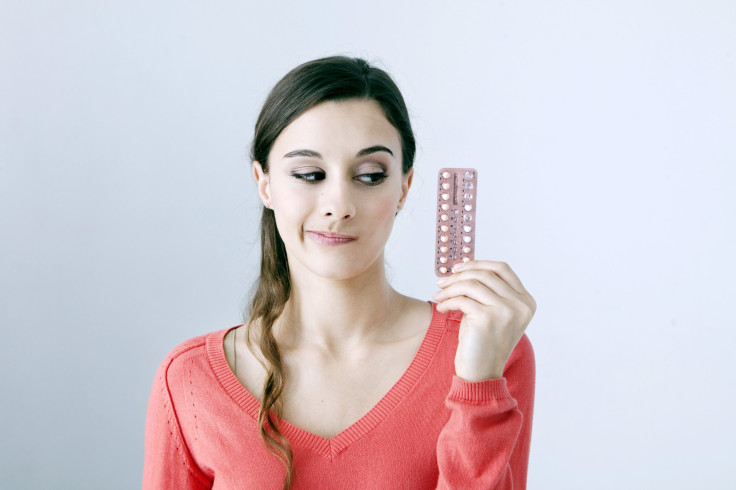Birth Control Options: The Truth Behind Common Birth Control Myths

Becoming a parent can be one of the most wonderful yet terrifying things to happen to a person. To ensure "the miracle of life" only occurs on your terms, it's best to know fact from fiction when it comes to birth control.
1. I’m On The Pill, So I’m Good
The only guaranteed form of birth control is abstinence. According to the Department of Health and Human Services, for every 100 women who use the birth control pill each year, about five are likely to get pregnant. This risk is much lower for women who take the pill every day at the same time, but still, factors such as a woman’s weight and interference with other medication can also lower the effectiveness of the pill.
"In some cases, the failure rate can be as high as 20 percent because they forget to take it regularly or they run out of pills and don't get a refill right away," Dr. Andrew M. Kaunitz, associate chairman of obstetrics and gynecology at the University of Florida College of Medicine told Shape. Also what many women don’t realize is although the birth control pill is effective in preventing unplanned pregnancies, it offers absolutely no protection against STDs.
2. The Morning After Pill Is The 'Abortion Pill'
Absolutely not. The morning after pill, also known as Plan B, stops the egg from coming into contact with the sperm altogether, The Atlantic reported. If the egg has been fertilized, the pill will have no effect. It will in no way abort a fertilized embryo. In fact, in Ireland, a country where abortion is illegal, the emergency contraceptive pill is fully available to the public at most local pharmacies. The pill is effective up to three days after unprotected sex and has proven to be between 52 percent and 85 percent useful in preventing unintended pregnancies.
3. If You Go On The Pill, You May Never Be Able To Get Pregnant
According to most doctors, this claim is most probably not true. The European Active Surveillance Study on Oral Contraceptives followed more than 2,000 women that had stopped taking the pill in order to conceive. After two years, the organization concluded that the pill did not make any difference to future conception, Today Health reported.
“With a few notable exceptions, immediately after you stop using birth control, your fertility will go right back to what it was destined to be,” Dr. Paul Blumenthal, professor of obstetrics and gynecology at Johns Hopkins University Medical School told Parenting. What this translates to is: If you go on the pill at 18 and come off when you’re ready to conceive at 30, your fertility should be the same as an average 30-year-old. Problems conceiving may be attributed to age, rather than years of being on the hormonal contraceptive, the website explained.
4. The Birth Control Pill Has No Serious Complications
The National Blood Clot Alliance reported the birth control pill increases the chance of developing a blood clot by about three to four percent. This risk is attributed to estrogen, a key ingredient in the birth control pill, patches, and rings. Although the hormone does not cause blood clots, it does increase the levels of clotting factors.
The birth control pill, Yasmin or Yaz, has been at the center of controversy lately after reports emerged that the birth control pill increased a women’s risk of developing blood clots even more than older medications, the Daily Mail reported. A recent Yasmin settlement resulted in a $14 million award for the plaintiff, and as of June 2, a total of 11,677 Yasmin and Yaz lawsuits have been filed in the U.S. district courts. In 2012, the FDA mandated that Yasmin and other newer birth control pill revise their label to correctly detail the potential risk of blood clots, TIME reported.

5. Only Promiscuous Girls Use Birth Control
According to a survey taken by the Guttmacher Institute, of sexually active women between the ages of 15 and 44 living in America, a total of 99 percent have used at least one contraceptive method. So clearly unless you believe that the entire United States is made up of nothing but promiscuous women, this claim is completely untrue. In 2010, a total of 27.5 percent of U.S. women who practiced birth control used the birth control pill. In religious couples, 68 percent of Catholics, 73 percent of Protestants, and 74 percent of Evangelicals practiced a form of hormonal birth control, had an IUD, or had undergone surgical sterilization.
It was also shown that even with easier access to birth control, such as what is offered under Obamacare, women and teen girls “did not take up riskier sexual practices as a result,” a study from the Contraceptive Choice Project found, as reported by the Detroit Free Press. Increasing access to no-cost contraceptives doesn’t translate into riskier sexual behavior. It’s not the contraception that drives their sexual behavior,” senior author of the study, Jeffrey Peipert explained to Feminsting.
6.The Rhythm Method Doesn’t Work
Although perhaps the least popular of birth control methods, don’t laugh off the rhythm system just yet. It’s true that this form of birth control does mean a woman is responsible for charting and interpreting her fertility on a daily basis, but when used perfectly, it has a 95 to 98 percent effective rate. For typical users, a.k.a. those who may not always follow the rules, the effectiveness falls to about 75 to 88 percent.
Still, there is something that the rhythm method is extremely useful for: helping women actually get pregnant. When using the rhythm method, a woman is able to discover her fertility window and therefore significantly increase her chances of falling pregnant, if this is her ultimate goal. Women aren’t fertile every day of the month, so the rhythm system can help a couple to highlight the days when the woman is most likely to get pregnant.




























